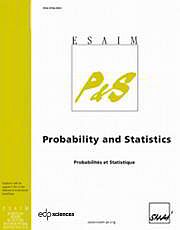Article contents
Coupling a branching process to an infinite dimensional epidemic process* **
Published online by Cambridge University Press: 15 December 2008
Abstract
Branching process approximation to the initial stages of an epidemicprocess has been used since the 1950's as a technique for providing stochastic counterparts to deterministic epidemic threshold theorems.One way of describing the approximation is to construct both branching and epidemic processes on the same probability space, insuch a way that their paths coincide for as long as possible. Inthis paper, it is shown, in the context of a Markovian model of parasiticinfection, that coincidence can be achieved with asymptotically high probability until MN infections have occurred, as long asMN = o(N 2/3), where N denotes the total number of hosts.
- Type
- Research Article
- Information
- Copyright
- © EDP Sciences, SMAI, 2010
Footnotes
Work supported in part by Schweizerischer Nationalfonds Projekt No. 20–117625/1.
To Cindy Greenwood, for her 70th.
References
- 5
- Cited by


